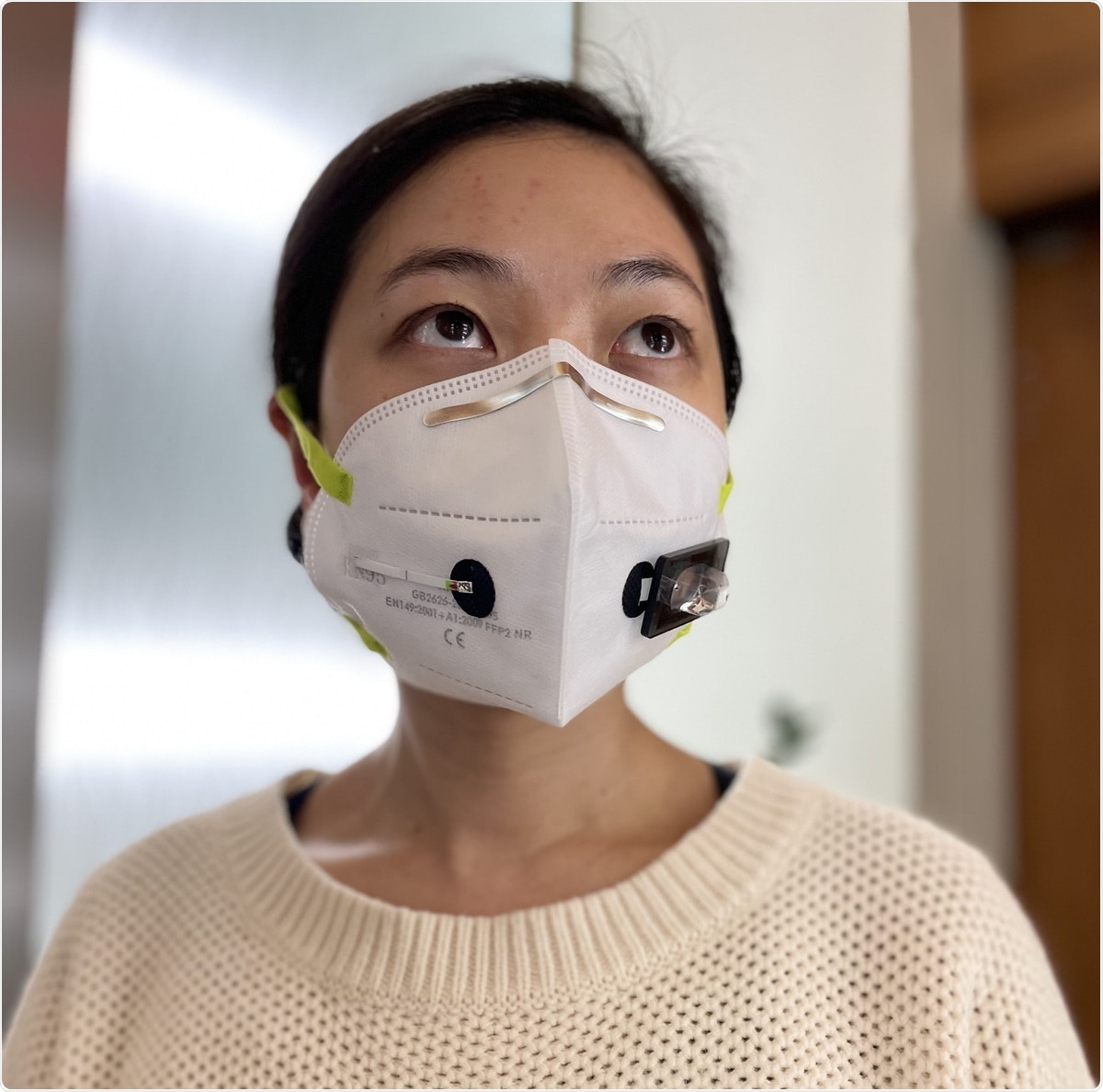A collaborative effort between the Wyss Institute for Biologically Inspired Engineering at Harvard University and the Massachusetts Institute of Technology (MIT) recently published their findings on how novel technology can be incorporated into standard face masks to detect the presence of the severe acute respiratory syndrome coronavirus 2 (SARS-CoV-2).

Face Mask that can detect SARS-CoV-2. Image Credit: Wyss Institute at Harvard University
An introduction to synthetic biology
Synthetic biology is a multidisciplinary field that utilizes various engineering principles to gain control over a wide range of biological parameters. As a result, synthetic biology has been the foundation of many recent advancements that have been made in the fields of biotechnology and medicine.
Some of the different engineering elements that have been incorporated into these biomedical technologies include oscillators, switches, logic gates, amplifiers, timers, counters, memories, sensors, and actuators. Within the field of sensor science and technology, synthetic biology allowed researchers to create inexpensive and rapid sensors that can be used for disease diagnosis and monitoring in real-world environments.
Previous advancements in the field of synthetic biology have led to the development of new cellular sensors that maintain their natural sensing ability to detect a variety of molecular and environmental targets. These new cellular sensors can operate alone or be coupled with electronics to form uniquely sensitive transducers that have been used for a variety of applications, ranging from water quality testing to detecting toxins in war zones.
What is wFDCF technology?
Recently, researchers from MIT have published their findings on a novel wearable freeze-dried cell-free (wFDCF) technology that uses genetically encoded sensors for the detection of bodily metabolites, pathogen biomarkers, chemical toxins, and other environmental substrates. The development of this technology was largely based on previous findings demonstrating that the biomolecular components that are required for these sensing applications can be freeze-dried to expand their shelf-life while simultaneously preserving their stability during transportation and storage for extended periods.
In terms of safety, the wFDCF technology eliminates many of the potential safety concerns that often arise when using biosensing platforms that are based on living cells. The wFDCF technology described in the current article was first used as a paper-based nucleic acid system to assist in the diagnosis of the Zika virus during the 2015 outbreak. In that system, pathogen-derived ribonucleic acid (RNA) molecules were coupled with a green fluorescent protein (GFP) that formed the genetically engineered circuit for the biosensor. The circuit was then embedded into porous paper substrates that produce a higher fluorescent signal when exposed to the Zika virus.
SARS-CoV-2 sensors in face masks
In addition to paper, the wFDCF platform technologies can also be directly incorporated into synthetic and natural substrates, such as polymer matrices and certain textiles like thread, weaves, fibers, as well as complex fabrics. To this end, the researchers of the current study were interested in integrating this novel technology into standard face masks to detect the presence of SARS-CoV-2 in a patient’s breath. The technology behind this coronavirus disease 2019 (COVID-19)-detecting face mask appears to achieve accuracy rates that are comparable to reverse transcriptase-polymerase chain reaction (RT-PCR) tests that are often used to diagnose COVID-19 in the clinical setting.
The COVID-19-detecting face mask consists of three different lyophilized biological reactions that are activated by the release of water from a reservoir that pushes a small button. The first of these reactions opens the SARS-CoV-2 virus member to expose its genetic RNA material. The gene that encodes for the SARS-CoV-2 spike protein, which is the surface protein that allows for the virus to penetrates human cells, is then isolated and copied into numerous double-strand versions.
The final reaction uses clustered regularly interspaced short palindromic repeats (CRISPR)-based SHERLOCK technology to detect any gene fragments of the spike protein in the breath. Upon the detection of any gene fragments, a probe molecule is cut into two smaller pieces and then get reported through a lateral flow assay strip embedded within the mask. If spike protein fragments are found and cut, a SARS-CoV-2 diagnosis will therefore be positive. Similar to the positive result that arises when at-home pregnancy tests are used, a change in the pattern of lines on the mask will confirm the presence of SARS-CoV-2.
Future applications
This work shows that our freeze-dried, cell-free synthetic biology technology can be extended to wearables and harnessed for novel diagnostic applications, including the development of a face mask diagnostic.”
Although the current version of the COVID-19-detecting face mask is free from electronic components, the researchers have found that they can integrate permanent elements into this system for more expansive diagnostic applications. To this end, a network of fiber optic cables can be integrated into the wFCDF technology to detect fluorescent light that is generated following the occurrence of various biological reactions.
The result of these reactions can then be transmitted to smartphone apps to allow the wearer to monitor their exposure to various substances over extended periods. For example, the researchers suggest that this technology could be used in lab coats for scientists who work with hazardous materials or pathogens. Similarly, physicians and nurses could also wear textiles that contain these wFCDF sensors to monitor their exposure to dangerous pathogens or toxins.
- Nguyen, P.Q., Soenksen, L.R., Donghia, N.M. , et al. Wearable materials with embedded synthetic biology sensors for biomolecule detection. Nat Biotechnol (2021). https://doi.org/10.1038/s41587-021-00950-3
https://news.google.com/__i/rss/rd/articles/CBMia2h0dHBzOi8vd3d3Lm5ld3MtbWVkaWNhbC5uZXQvbmV3cy8yMDIxMDYyOS9UaGUtdGVjaG5vbG9neS1iZWhpbmQtZmFjZS1tYXNrcy10aGF0LWNhbi1kaWFnbm9zZS1DT1ZJRC0xOS5hc3B40gFvaHR0cHM6Ly93d3cubmV3cy1tZWRpY2FsLm5ldC9hbXAvbmV3cy8yMDIxMDYyOS9UaGUtdGVjaG5vbG9neS1iZWhpbmQtZmFjZS1tYXNrcy10aGF0LWNhbi1kaWFnbm9zZS1DT1ZJRC0xOS5hc3B4?oc=5
2021-06-29 13:26:00Z
52781700367379
Bagikan Berita Ini














0 Response to "The technology behind face masks that can diagnose COVID-19 - News-Medical.Net"
Post a Comment